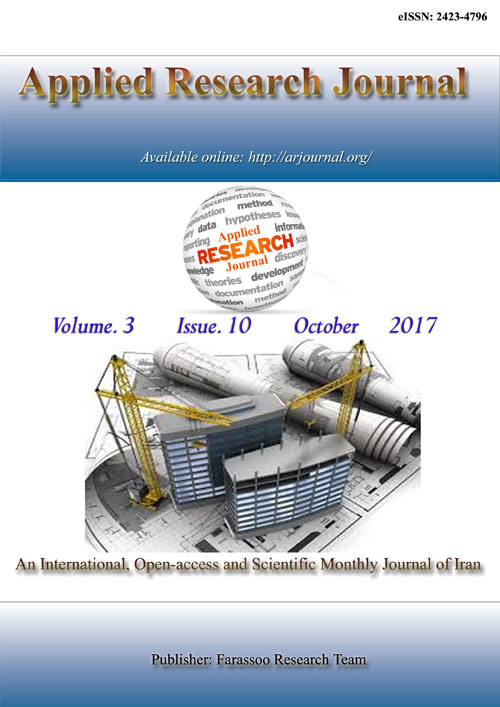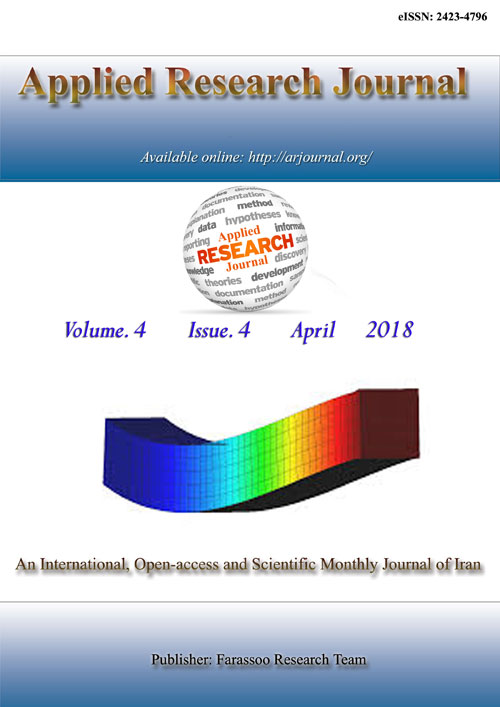فهرست مطالب

Applied Research Journal
Volume:3 Issue: 10, Oct 2017
- تاریخ انتشار: 1396/09/20
- تعداد عناوین: 3
-
Pages 295-304This study deals the numerical investigation of heat transfer along symmetrical porous wedge and effect of radiation in the presence of variable fluid viscosity on flow. The fluid viscosity is considered to vary as a linear function of temperature. The symmetry groups admitted by the corresponding boundary value problem are obtained by using special form of Lie group transformation. The third order and second order coupled ordinary differential equation system corresponding to the momentum and the energy equations are obtained. These equations are solved numerically by Matlab software using ode45 solver. In this paper we study the effects of various parameters like as Prandtl number (Pr), Porous Parameter (∗), Viscosity Parameter (A), Falkner Skan Exponent (m), Radiative Heating parameter (Q) on the flow of fluid velocity and the heat transfer variable viscosity fluid.Keywords: Porous wedge, Variable Viscosity, Prandtl number Pr, Heat Transfer (G), Radiative heating parameter (Q). Temperature dependent viscosity parameter (A)
-
Pages 305-313In this experimental study of natural convective heat transfer in a HeleShaw cell and flow pattern analysis is performed. For this purpose HeleShaw cell with dimensions of 20 × 20 cm plus temperature and flow rate measurement tools built into the cell with the base fluid (water) and nanofluid (water-Copper) is filled. Nano copper in water-based fluid in three different concentrations of 0.01, 0.02 and 0.04% by volume and made the two-step method for homogenization of physical methods (mixing and vibration by Ultrasonic probe and Ultrasonic bath) and chemical methods (the active surface) was used. Tests on five heat flux, in two different discharges and in three different angles relative to ground level (zero degree, 45 degree and 90 degree) has been done. On this issue, the coefficient of heat transfer, Nusselt and Rayleigh number calculated and how the flow pattern is examined. To view the flow pattern in the display device with Hele-Shaw cell from c-etching method used. Using data obtained from Rayleigh number range between 103 to 105 and the range of heat transfer is between 8 to 105, the highest number in heat flux heat transfer in nanofluids 494 W and is water-copper with 0.04% vol. Analysis of results and calculate the heat transfer coefficient of nanofluids studied for an increase of over 32% compared to pure water. The results show that with increasing discharge, heat transfer coefficient increases. Values are determined with a maximum uncertainty of results is equal to ± 2.2.Keywords: Natural convection, Nanofluid, Fluid Flow, Hele-Shaw cell
-
Pages 314-320Pakistan is a developing country, and like most developing countries it utilizes a considerable portion of its annual budget on development projects particularly in highways and roads infrastructure. Development and construction of highways and roads may however have a negative impact on the surrounding environment. To control this negative impact, green and sustainable highway initiatives have been undertaken in Some European countries and in North America. Rating systems have been developed in these countries to determine the sustainable performance of highways. Pakistan does not have a rating system and thus, to develop a rating system, it is necessary to identify the criteria across which the rating system will measure the sustainable performance of highways. This paper, therefore, aims to identify sustainable criteria elements in highway projects lifecycle. The identification process was completed by means of reviewing literature and by comparing other rating systems. As a result different sustainable criteria and sub criteria elements were identified in different phases of lifecycle of Highways I,e Planning, Design, Construction and Operation and Maintenance.Keywords: Sustainability, Sustainable Development, Roads, Sustainable Highways, Sustainable Criteria Elements, Highway Project Life Cycle


